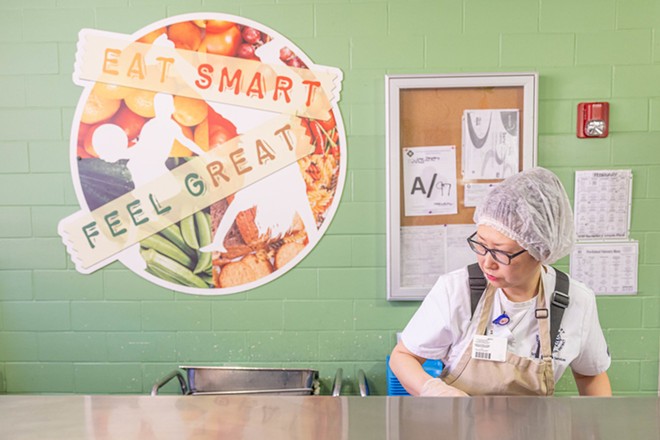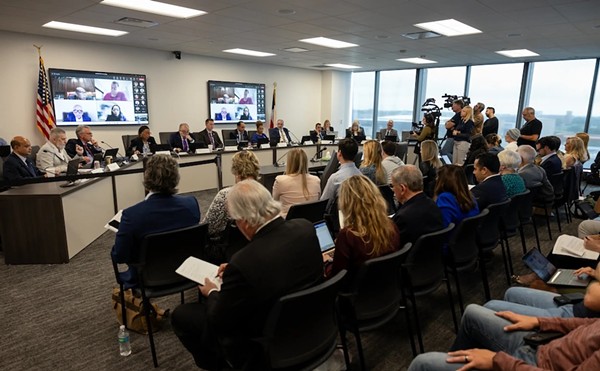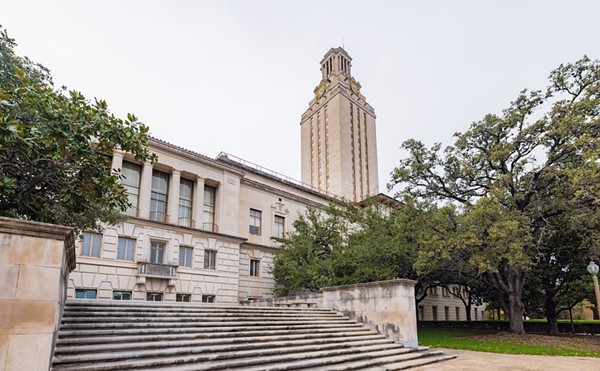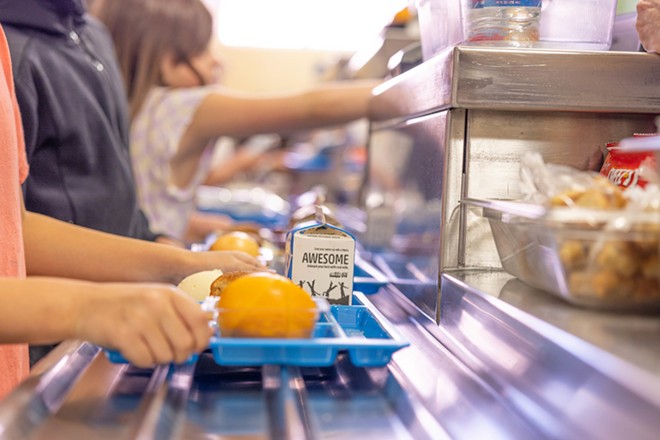
Now that guarantee looks considerably less certain. Since the end of pandemic-era federal waivers that offered free lunch to 50 million kids nationwide, public school meal programs face rising food costs, staffing shortages, supply chain issues and a growing pile of unpaid debt.
Experts including the School Nutrition Association (SNA), a national organization representing 50,000 members, warn that those pressures could build into a full-blown financial crisis as early as this July.
That's when Congress' post-pandemic Keep Kids Fed Act will expire. The act's goal was to combat cost and supply issues with federal reimbursement for lunch programs for the 2022-2023 school year. However, the fiscal help fell short, according to some school nutrition directors.
And without any additional federal help — however meager — school lunch programs in San Antonio and across the country could be face unprecedented financial struggles.
"We are really concerned [whether] we will be financially stable," said Sharon Glosson, executive director of school nutrition at North East Independent School District. "We are expected to be self-sustaining and profitable, but we don't have a safety net."
NEISD alone serves 60,000 meals daily, spread across breakfast, lunch and dinner, according to Glosson. Some 3 million Texas students rely on the National School Lunch Program.
Unless federal lawmakers decide to intervene, nutritional directors in San Antonio and other parts of the country may be left with the dilemma of turning kids away from the lunch lines or finding ways to pay off mounting debt.
So far, districts nationwide appear to be opting for the latter, experts say. But with public school lunch programs becoming a potential drain on schools' finances, that could put educational necessities such as textbooks, computers and teacher pay at risk.
A school district in Central Kansas has already racked up $85,000 in unpaid meal debt, for example. With the school year far from over, the district is considering plans to dip into its general fund to cover the money.
Covering costs
Exacerbating the financial woes is a federal rule that lunch programs can't carry over debt from the previous school year.
School lunch programs generally try to provide meals for students who show up without money, even those who don't qualify for a free lunch because of their family's income level. Many districts are seeing the numbers for those unpaid meals go up, escalating their debt.
That means some districts may be stuck covering for meals while they're also on the hook for vendor tabs that can run into the tens of thousands of dollars. All as the academic year closes out.
"Schools are permitted to carry meal debt through the school year as they work to collect funds owed from families," SNA spokesperson Diane Pratt-Heavner told the Current via email. "Having the district pay off the debt won't be required until the end of the school year."
During the current school year, eight states offer free meals to all students, according to SNA data. Texas isn't one of them. In other words, Texas isn't legally required to provide free meals, regardless of circumstances.
"If a student is not eligible for free school meals and enrolled in the program, and the child does not have money to pay for a meal, there is no federal mandate to serve the child a meal," Pratt-Heavner explained. "However, several states have passed legislation mandating the service of school meals to any child who requests one."
According to the Texas Education code, Texas schools are "given a grace period for charging meals when they no longer have funds in their student account." Each district sets its own grace period, meaning there's no statewide guarantee of how long that may last.
Post-pandemic turmoil
Like private businesses, school lunch programs are being roiled by the economic uncertainty that came during the winddown of the pandemic — among them supply shortages, labor issues and inflation.
During the height of the health crisis, federal lawmakers made public school lunch free to more than 50 million students nationwide — at the cost of roughly $11 billion annually. The program was a clear-cut solution to ensure every child, no matter the family's income level, got fed at least once a day. No questions asked.
For a moment, the unprecedented move gave families a sliver of food security during one of the most unstable times in recent memory.
However, federal lawmakers nixed the program just before the start of the 2022-2023 school year. When it vanished, school meal programs experienced a rise in families unable to keep money in their kids' meal accounts.
The average cost of a school lunch is roughly $3.81 nationally. At NEISD, elementary school lunches run $2.40. While the meals are inexpensive, it's still easy to understand how cash-strapped families might not be able to keep their kids' accounts up to date.
Since the federal free-lunch guarantee ended, schools in San Antonio have been forced to return to an income-based model stemming from the 76-year-old National School Lunch Act.
Under those guidelines, children from families whose income is 130% of the federal poverty line receive a free lunch. Those whose families struggle financially but are further above the poverty line qualify for a reduced-cost lunch, while the rest must pay full price.
The USDA reimburses lunch programs monthly for each meal sold to a student at the checkout line. Each prepared meal that goes unsold contributes to the school's debt load since federal reimbursement doesn't cover those.
The National School Lunch Act doesn't consider factors such as the cost of living, inflation or familial relationships when determining its payouts. That's becoming increasingly problematic as families struggle with rising prices and economic uncertainty, experts maintain.
Counting pennies
Even under Congress' Keep Kids Fed Act, which was designed to address inflation and other pressures, reimbursement under the program often runs a few cents short of what it costs to produce a school lunch, according to NEISD's Glosson. Scaled up across an entire district, those pennies start to add up.
According to a recent SNA survey, 56.6% of school lunch programs said reimbursement rates under the Keep Kids Fed Act failed to cover their cost of producing meals.
NEISD's Glosson and others worry the shortfall will only grow once Keep Kids Fed expires in July.
SNA officials said the most vulnerable children are those of families who slightly miss the National School Lunch Act's financial cutoff and don't attend a district that the federal government deems economically disadvantaged. In those districts with that designation, all students qualify for free meals.
"Some families can miss the income requirement by as little as $100," SNA's Pratt-Heavner said of the kids in districts that don't qualify for across-the-board free lunches.
Further complicating matters, not all parents whose children should qualify for free meals fill out the paperwork to enroll. According to SNA, 90.6% of programs that must collect meal applications reported a challenge getting families to submit the forms.
Along with income verification, the forms request sensitive information such as income verification and Social Security numbers. Social Security numbers also are unavailable to undocumented immigrant families.
Louisa R. Kates, director of school nutrition services at NEISD, said the requirement for income-based forms bears some of the blame for dwindling participation in school lunch programs.
"I've seen a 10-15% drop in meals [purchased] since before pandemic era times," she said.
With that large of a drop in student participation in the program, Kates' biggest fear is that students are simply not eating.
Fewer meals, fewer funds
For NEISD, that drop in meal purchases translates to a 10-15% drop in federal reimbursement funds. The government money goes to cover everything from operation costs, equipment repairs and staff pay.
The looming loss of those federal funds also comes as NEISD and other districts grapple with the same kind of staffing, supply and inflation issues hammering the restaurant industry.
NEISD has been forced to close some lunch lines due to a lack of staff, leading to longer wait times and more strain on already overworked and understaffed cafeterias.
"Prior to [COVID] we had seven serving lines. Now we have four," Kates said, referring to one particularly hard-hit campus.
In 2020, NEISD paid $57.35 for a 40-pound box of ground beef, according to district officials. Three years later, that same box is running $141.93. Nonedible items such as paper goods have also cut into the bottom line.
Just as restaurants have raised menu prices over the past couple of years to avoid going into the red, schools are being forced to do the same.
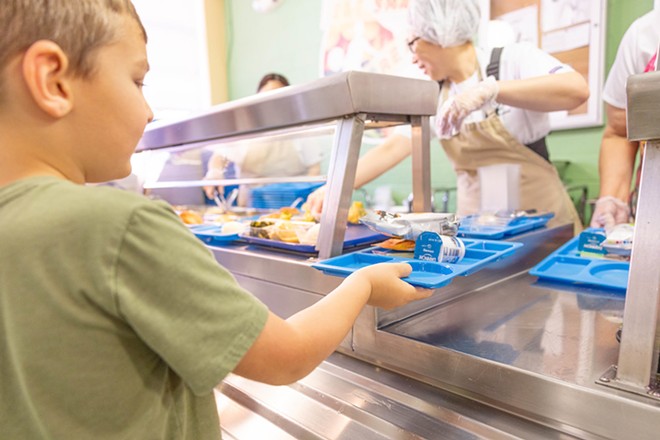
Desperate measures
Districts nationwide are making cuts to keep their lunch programs solvent and zero out debt at the end of the school year. Some have even requested financial assistance from strangers.
Schools in Central Kansas' Salina County are buried under $85,000 in unpaid school lunch debt, forcing the district to ponder tough cutbacks, according to a recent Salina Journal report. Local churches and private individuals offered donations to ease some of the schools' unpaid debt.
More than 70% of the debt in Salina County is from families on full-pay status, according to the report.
Jefferson County public schools in Louisville, Kentucky, are facing similar issues. The nine schools not considered economically disadvantaged in that district have racked up $53,000 in unpaid meal debt this year, according to a report in trade industry publication Food Service Direct.
That debt is expected to rise to nearly $100,000 by the end of the school year, the district's assistant director of nutrition, Dan Ellnor, told the news outlet.
Some districts have become so saddled with debt that they have reportedly resorted to seeking help through GoFundMe campaigns and social media posts.
In January, a teacher at Rocky Mountain Middle School in Heber City, Utah, posted a TikTok video requesting donations to cover that school's meal debt. The clip garnered more than $30,000 in donations, according to a recent ABC News report.
Spreading to SA?
San Antonio's school districts haven't reached that level of worry. Not yet, anyway. NEISD's meal debt hovers at around $9,000, according to officials there.
San Antonio's comparatively low levels of unpaid school lunch debt comes down to the number of schools or entire districts in the city that that the feds consider economically disadvantaged, experts said.
However, events unfolding in other states may offer warning signs for schools that don't qualify for free lunches for all students.
For nutritional directors in San Antonio and around the country, the answer is for Congress to bring back universal free lunches, or failing that, to raise reimbursement rates to adequate levels.
Congressional help?
SNA's Pratt-Heavner told the Current her organization is urging federal lawmakers to consider reinstating the pandemic-era free lunch program.
Even if such a sweeping change doesn't occur, two bills introduced in the U.S. House of Representatives aim to provide better reimbursement.
U.S. Rep. James P. McGovern, D-Massachusetts, introduced the Healthy Meals Help Kids Learn Act, which will permanently increase the federal reimbursement level for all free, reduced-price and paid-rate school meals. The rate would go up by 45 cents for every lunch served and 28 cents for every breakfast served, including a yearly adjustment.
U.S. Rep. Abigail Spanberger, D-Virginia, and U.S. Rep. Brian Fitzpatrick, R-Pennsylvania, also introduced the Help Schools Feed Students Act. Their bill will assist schools as they continue to provide meals to students and insulate them from the impacts of inflation.
"Congress must advance these proposals quickly to avert the financial crisis in July," Pratt-Heavner said.
Despite the promise of those two bills, Congress has yet to pass anything affecting next year's reimbursement rates. As a result, many districts are left wondering when help will arrive, if at all.
The longer federal lawmakers wait to address issue, the greater the potential children will go hungry.
"I personally would like to see expansion of all students eating at no charge: universal feeding," NEISD's Kates said. "[That way,] we don't have to worry about meal debt and having to cut off children who cannot pay. The worst day in any cafeteria worker's life is saying, 'You have to get an alternative meal. You can't get what you want.'"
Follow us: Google News | NewsBreak | Instagram | Facebook | Twitter

